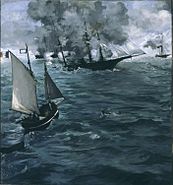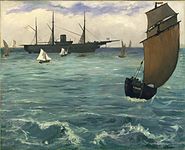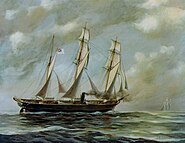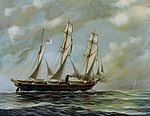| Battle of Cherbourg | |||||||
|---|---|---|---|---|---|---|---|
| Part of the American Civil War | |||||||
 Sinking of the CSS Alabama (1922), by Xanthus Smith, Franklin D. Roosevelt Presidential Library, Hyde Park, New York. | |||||||
| |||||||
| Belligerents | |||||||
|
|
| ||||||
| Commanders and leaders | |||||||
| John Winslow | Raphael Semmes | ||||||
| Units involved | |||||||
| USS Kearsarge (1861) | CSS Alabama | ||||||
| Strength | |||||||
| 1 sloop-of-war | 1 screw sloop-of-war | ||||||
| Casualties and losses | |||||||
|
1 killed 2 wounded |
1 ship sunk ~40 killed ~70 captured | ||||||
|
| |||||||
| |||||
The Battle of Cherbourg, or sometimes the Battle off Cherbourg or the Sinking of CSS Alabama, was a single-ship action fought during the American Civil War between a United States Navy warship, the USS Kearsarge, and a Confederate States Navy warship, the CSS Alabama, on June 19, 1864, off Cherbourg, France.
Background
After five successful commerce raiding missions in the Atlantic Ocean, CSS Alabama turned into Cherbourg Harbor on June 11, 1864. The rebel sloop-of-war was commanded by Captain Raphael Semmes, formerly of CSS Sumter. It was Captain Semmes' intention to dry dock his ship and receive repairs at the French port. The Confederate Navy vessel was crewed by about 170 men and armed with six 32-pound (15 kg) cannons, one 110-pounder (50 kg) and one 68-pound (31 kg) gun. The Alabama had been pursued for two years by the screw sloop-of-war USS Kearsarge, under Captain John Winslow. The Kearsarge was armed with two 11-inch (280 mm) smoothbore Dahlgren guns which fired approximately 166 pounds of solid shot, four 32-pound guns and one 30-pounder Parrott rifle. She was manned by around 150 sailors and officers.
Kearsarge had armor-clad, chain cable triced in tiers along her port and starboard midsections. This armor protection gave the Union warship a possible advantage over the rebel raider. On June 14, Kearsarge finally caught up with Alabama as she was receiving repairs. Kearsarge did not attack; instead she waited, initiating a blockade of CSS Alabama in Cherbourg Harbor, France. Union Captain Winslow telegraphed USS St. Louis to request her assistance, but the fighting began before she could arrive. Confederate Captain Semmes used the time to drill his men for the coming battle. On June 19, CSS Alabama, with nowhere else to go, ran up the Stars and Bars and exited the harbor to attack Kearsarge. She was escorted by the French Navy ironclad Couronne,[1] whose mission was to ensure that the ensuing battle occurred outside the French harbor.
Battle

Battle of the USS Kearsarge and the CSS Alabama (1887 lithograph).
Men aboard USS Kearsarge spotted the incoming Confederate raider, so they turned their ship around to take the impending battle out of French territorial waters. Once out, Kearsarge turned about again, hoisted the United States Navy Jack, and lined up for a broadside. Captain Winslow ordered his gunners to hold their fire until the range closed. CSS Alabama fired the first shots. They are not known to have hit. Eventually Kearsarge was under way, and the range closed to within 1,000 yards (900 m) when she fired her first shot. The two warships maneuvered on opposite courses throughout the battle. Kearsarge and Alabama made seven spiraling circles around each others' ship, moving southwest in water moving at a current of 3 knots. Both Captain Semmes and Captain Winslow attempted to cross each others' bow, hoping to inflict heavy raking fire. The battle continued in this manner for several minutes; in the meantime, on the French Coast, hundreds of Cherbourg citizens watched the battle as it slowly drew closer to a Union victory. Kearsarge's armor cladding sustained two hits during the engagement.
The first shell, a 32-pounder, struck within the starboard gangway. The shot cut part of the chain armor and dented the metal hull underneath. The second shot was again a 32-pounder that caused further damage to the chain armor, and broke a link of the chain armor. Both hits struck the chain armor at just above five feet over the waterline. The gunnery of USS Kearsarge was reportedly more accurate than of the Confederates; she fired slowly with well-aimed shots, while Alabama fired rapidly. CSS Alabama fired a total of over 370 rounds during the fighting; it is not known how many Kearsarge fired, but it is known that she fired much less than the rebels did. Eventually, after just over an hour of exchanging artillery fire, Alabama had received shot-holes beneath the waterline from Kearsarge's Dahlgren guns and began to sink. Captain Semmes struck the Confederate colors, but still the Kearsarge continued firing until a white flag was seen, raised by one of the rebel sailors with his hand. The battle was over, so Captain Semmes sent his remaining dinghy to Captain Winslow, to ask for aid.
During the battle, over forty Confederate sailors were killed in action or drowned. Another seventy or so were picked up by Kearsarge. Thirty or so were rescued by the Deerhound, a British yacht, which Captain Winslow asked to help evacuate Alabama's crew. Captain Semmes and fourteen of his officers were among the sailors rescued by Deerhound. Instead of delivering the captured rebels to Kearsarge, the Deerhound set a course for Southampton, thus enabling Captain Semmes' escape. This act severely angered the Kearsarge's crew, who begged their captain to allow them to open fire on the British yacht. Captain Winslow would not allow this, though, so the Confederates got away and avoided imprisonment. Three men were wounded aboard the United States vessel, one of whom died the following day.
Aftermath

The sternpost of USS Kearsarge, with a 100-pound round embedded within it.
For many years after the battle, Confederate Captain Semmes stated that he would never have chosen to test USS Kearsarge had he known of her armor-clad protection. CSS Alabama had destroyed or captured dozens of Union merchant vessels during her Atlantic cruises; when word of Alabama's sinking reached the northeastern United States, many Northerners were joyful. Édouard Manet produced two paintings of the fight, The Battle of the Kearsarge and the Alabama, now at the Philadelphia Museum of Art and The Kearsarge at Boulogne, now at the Metropolitan Museum of Art. American marine artist Xanthus Smith painted six versions of the naval battle. The most famous of these, a massive work exhibited at the 1876 Centennial Exposition, is in the collection of the Union League of Philadelphia.
See also
- Bahia Incident
Gallery
References
- ↑ Combat naval à Cherbourg (1864), Wikimanche
- Semmes, Raphael, Admiral, CSN, Memoirs of Service Afloat During the War Between the States, Blue & Grey Press, 1987, ISBN 1-55521-177-1.
- Hearn, Chester G., Gray Raiders of the Sea, Louisiana State Press, 1996, ISBN 0-8071-2114-2.
- Luraghi, Raimondo, A History of the Confederate Navy, U. S. Naval Institute Press, 1996, ISBN 1-55750-527-6.
- Marvel, William, The Alabama & the Kearsarge: The Sailor's War, University of North Carolina Press, 1996, ISBN 0-8078-2294-9.
- Still, Jr., William N.; Taylor, John M.; Delaney, Norman C., Raiders and Blockaders, the American Civil War Afloat, Brassy's, Inc., 1998, ISBN 1-57488-164-7.
- Bowcock, Andrew, CSS Alabama, Anatomy of a Confederate Raider, Chatham Publishing, London, 2002, ISBN 1-86176-189-9.
- Gindlesperger, James, Fire on the Water: The USS Kearsarge and the CSS Alabama, Burd Street Press, 2005, ISBN 978-1-57249-378-0.
- Secretary of the Navy, Sinking of the Alabama—Destruction of the Alabama by the Kearsarge, annual report in the library of the Naval Historical Center, 1864, Washington, D.C., Navy Yard.
- Delaney, Norman C. (1973). "Old Beeswax": Raphael Semmes of the Alabama. Harrisburg, PA, Vol. 12, #8, December, 1973, Civil War Times Illustrated, No ISSN.
- Madaus, H. Michael, Rebel Flags Afloat: A Survey of the Surviving Flags of the Confederate States Navy, Revenue Service, and Merchant Marine. Winchester, MA (80-page special edition of The Flag Bulletin, #115), 1986, Flag Research Center, ISSN 0015-3370.
- Roberts, Arthur C., M.D. Reconstructing USS Kearsarge, 1864, Silver Springs, MD., Vol. 44, #4; Vol. 45, #s 1, 2, and 3, 1999, 2000, Nautical Research Journal, ISSN 0738-7245.
- Uncredited reporter, Confederate Flag Flies At Pulaski, Savannah, GA. (Depression-era newspaper article on W. P. Brooks' rescued CSS Alabama ensign being flown as part of a ceremony held on the parade ground at Fort Pulaski, GA), Savannah News-Press, printed around 1937.
Coordinates: 49°45′9″N 1°41′42″W / 49.7525°N 1.695°W
| |||||||||||||||||
The original article can be found at Battle of Cherbourg (1864) and the edit history here.











